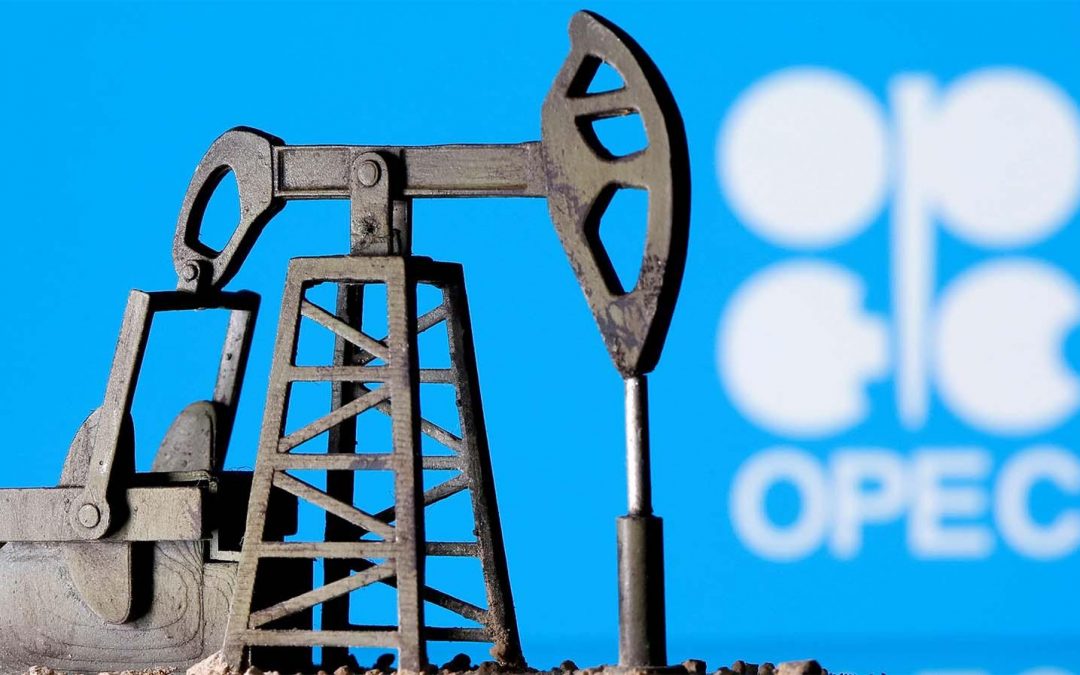Crude Oil Price Movements Crude oil spot prices dropped in April after three-consecutive months of rises. The OPEC Reference Basket dropped by $7.84, or 6.9%, to settle at $105.64/b. Crude futures prices declined m-o-m in April, amid elevated market volatility, fuelled by persistent uncertainty regarding market outlook. The ICE Brent front month fell $6.54, or 5.8%, in April to average $105.92/b and NYMEX WTI decreased by $6.62, or 6.1%, to average $101.64/b. Consequently, the Brent/WTI futures spread widened 8¢ to average $4.28/b. The market structure of all three major crude benchmarks – ICE Brent, NYMEX WTI and DME Oman – softened significantly, but remained in backwardation. Hedge funds and other money managers kept net long positions in WTI and Brent little changed after the previous month’s sharp selloff.
World Economy
World economic growth in 2022 is revised down to 3.5% from 3.9% in last month’s assessment, following growth of 5.8% in 2021. US GDP growth for 2022 is revised down to 3.2% from 3.8%, after growth was reported at 5.7% for 2021. Euro-zone economic growth for 2022 is revised down to 3.1% from 3.5%, following growth of 5.4% in 2021. Japan’s economic growth for 2022 is revised down to 1.8% from 1.9%, after growth of 1.7% in 2021. China’s 2022 growth is revised down to 5.1% from 5.3%, after growth of 8.1% in 2021. India’s 2022 GDP growth was revised down to 7.1% from 7.2%, after 2021 growth stood at 8.1%. Brazil’s economic growth forecast for 2022 is revised down to 0.7% from 1.2%, following growth of 4.6% in 2021. For Russia, the 2022 GDP growth forecast is revised down to show a contraction of 6%, compared with a contraction of 2% expected in last month’s assessment, which follows reported growth of 4.7% in 2021. Challenges related to ongoing geopolitical tensions, the continued pandemic, rising inflation, aggravated supply chain issues, high sovereign debt levels in many regions and expected monetary tightening by central banks in the US, the UK, Japan and the euro area require close monitoring.
World Oil Demand
World oil demand growth in 2021 remains broadly unchanged from the previous month’s assessment at 5.7 mb/d. World oil demand growth in 2022 is expected to increase by 3.4 mb/d y-o-y, representing a downward revision of 0.3 mb/d from last month’s report, with 1.8 mb/d in the OECD and 1.6 mb/d in the non-OECD. Oil demand growth in 2Q22 is projected to be slower at 2.8 mb/d, compared with 5.2 mb/d in 1Q22. Demand in 2022 is expected to be impacted by ongoing geopolitical developments in Eastern Europe, as well as COVID-19 pandemic restrictions.
World Oil Supply
Non-OPEC liquids supply growth y-o-y in 2021 is broadly unchanged at around 0.6 mb/d. Total US liquids production is estimated to have increased y-o-y by 0.15 mb/d. Non-OPEC supply growth for 2022 is revised down by 0.3 mb/d y-o-y to 2.4 mb/d. Russia’s liquids production for 2022 is revised down by 0.36 mb/d. The US liquids supply growth forecast for 2022 is broadly unchanged at 1.29 mb/d. The main drivers of liquids supply growth for the year are expected to be the US, Canada, Brazil, Kazakhstan, Guyana and Norway. OPEC NGLs are forecast to grow by 0.1 mb/d both in 2021 and 2022 to average 5.1 mb/d and 5.3 mb/d, respectively. OPEC-13 crude oil production in April, increased by 153 tb/d m-o-m, to average 28.65 mb/d, according to available secondary sources.
Product Markets and Refining Operations
Refinery margins on all main trading hubs continued to soar in April, amid a continued tightening in global product balances, and lower crude prices. Favourable product demand-side dynamics, as the overall negative impact of Covid-19 further diminishes on a global level, strengthened fuel markets in general, including that of jet fuel, despite some mobility restrictions in a few Asian countries. Middle distillates were the main margin contributor over the month, while their margins spread widened further versus that of gasoline. Going forward, refinery intakes are expected to rise and that could provide partial relief to the global product shortage, and potentially de-pressure product prices.
Tanker Market
Suezmax and Aframax rates continued to outperform those in the VLCC class, with gains of 61% and 28% m-o-m. The Suezmax market was supported by a strong market in the Atlantic basin while Aframax saw from support from both the East and West markets. After a sluggish start to the year, VLCC rates finally saw a pickup of 24%. However, gains were short-lived dissipating by the end of the month amid ample availability. Clean rates continued to perform well, gaining a further 15%. The market has been supported by strength in the East and rising activity in tanker demand West of Suez, amid preparations ahead of the driving season in the Northern Hemisphere.
Crude and Refined Products Trade
Preliminary data shows US crude imports declined to an 11-month low of 5.9 mb/d in April, while exports averaged 3.4 mb/d for a gain of 5% m-o-m. US product exports strengthened for the seventh month in a row, averaging 6.4 mb/d, supported by strong flows to Latin America and increasing flows to Europe. In March, China’s crude imports averaged 10.1 mb/d, recovering from the weak performance the month before. Recently released customs data shows China’s crude imports increased to 10.5 mb/d in April, despite expectations that reduced demand due to COVID-19 lockdowns would weigh on imports. China’s product imports declined 8%, while product exports rebounded, amid unexpectedly strong gasoil outflows. With domestic demand impacted by lockdowns, China’s product outflows are likely to be higher than previously expected in April, particularly for jet fuel. India’s crude imports dipped in March, but remained near the strong performance seen over the previous four months, averaging 4.5 mb/d for the month. Product exports saw a robust increase of 26% or about 0.3 mb/d to average 1.7 mb/d in March, the highest since September 2013, as Europe sought alternatives to Russian oil product flows. Japan’s crude imports have risen steadily since the start of the year, averaging 2.9 mb/d in March, amid healthy demand.
Commercial Stock Movements
Preliminary March data showed total OECD commercial oil stocks increasing m-o-m by 10.1 mb. At 2,621 mb, inventories were 298 mb lower than the same time a year ago, 304 mb lower than the latest five-year average, and 293 mb below the 2015–2019 average. Within the components, crude stocks rose m-o-m by 12.9 mb, while products stocks fell m-o-m by 2.8 mb. At 1,265 mb, OECD crude stocks were 189 mb lower than the latest five-year average and 198 mb below the 2015-2019 average. OECD product stocks stood at 1,356 mb, representing a deficit of 115 mb compared with the latest five-year average and 95 mb below the 2015–2019 average. In terms of days of forward cover, OECD commercial stocks fell m-o-m by 0.3 days in March to stand at 57.4 days. This is 8.8 days below March 2021 levels, 8.7 days less than the latest five-year average, and 5.0 days lower than the 2015–2019 average.
Balance of Supply and Demand
Demand for OPEC crude in 2021 was revised up by 0.1 mb/d from the previous month’s assessment to stand at 28.2 mb/d, which is around 5.0 mb/d higher than in 2020. Demand for OPEC crude in 2022 was revised up by 0.1 mb/d from the previous month to stand at 29.0 mb/d, which is around 0.8 mb/d higher than in 2021.
Source: Hellenic Shipping News






